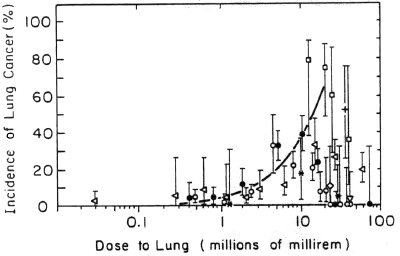In "The Nuclear Energy Option, Chapter 13, Plutonium and Bombs" (Plenum Press, 1990, ISBN 0-306-43567-5), Bernard L. Cohen writes:
When plutonium oxide, the form in which plutonium would be used in the
nuclear industry and also its most toxic form, is inhaled as a fine
dust, 25% of it deposits in the lung, 38% deposits in the upper
respiratory tract, and the remainder is exhaled. Within a few hours,
all of that deposited in the upper respiratory tract, but only 40% of
that deposited in the lung, is cleared out. The other 60% of the
latter — (.25 x .60 =) 15% of the total inhaled — remains in the lung
for a rather long time, an average of 2 years.
[...]
The 2 million fatalities per pound inhaled leaves plutonium dust far
from "the most toxic substance known to man." Biological agents, like
botulism toxin or anthrax spores are many hundreds or thousands of
times more toxic. Plutonium toxicity is similar to that of nerve
gas, but given the choice of being in a room with equal quantities
of plutonium dust and nerve gas, the latter would be infinitely more
dangerous. It rapidly permeates the room air, whereas plutonium, being
a solid material, would be largely immobile.
[...]
The calculational procedure used here to obtain our result, 2 million
deaths per pound inhaled, follows the recommendations of the
International Commission on Radiological Protection (ICRP). It would
be impossible to obtain a very different result without sharply
deviating from them; at least three independent investigations have
used them to evaluate the toxicity of plutonium and they have all
obtained essentially the same result. These ICRP recommendations are
used by all groups charged with setting health standards all over the
world, such as the Environmental Protection Agency and the
Occupational Safety and Health Administration in the United States.
They are almost universally used in the scientific literature.
[...]
It is 5,000 times more dangerous to inhale plutonium than to eat it, and eating plutonium is about equal in danger to eating the same quantity of caffeine.
He also states that:
There is no direct evidence for plutonium-induced cancer in humans,
but there have been a number of experiments on dogs, rabbits, rats,
and mice. The results of these are summarized in Fig. 1, where the
curve shows the expectation from our calculation. It is evident that
the animal data give strong confirmation for the validity of the
calculation.

